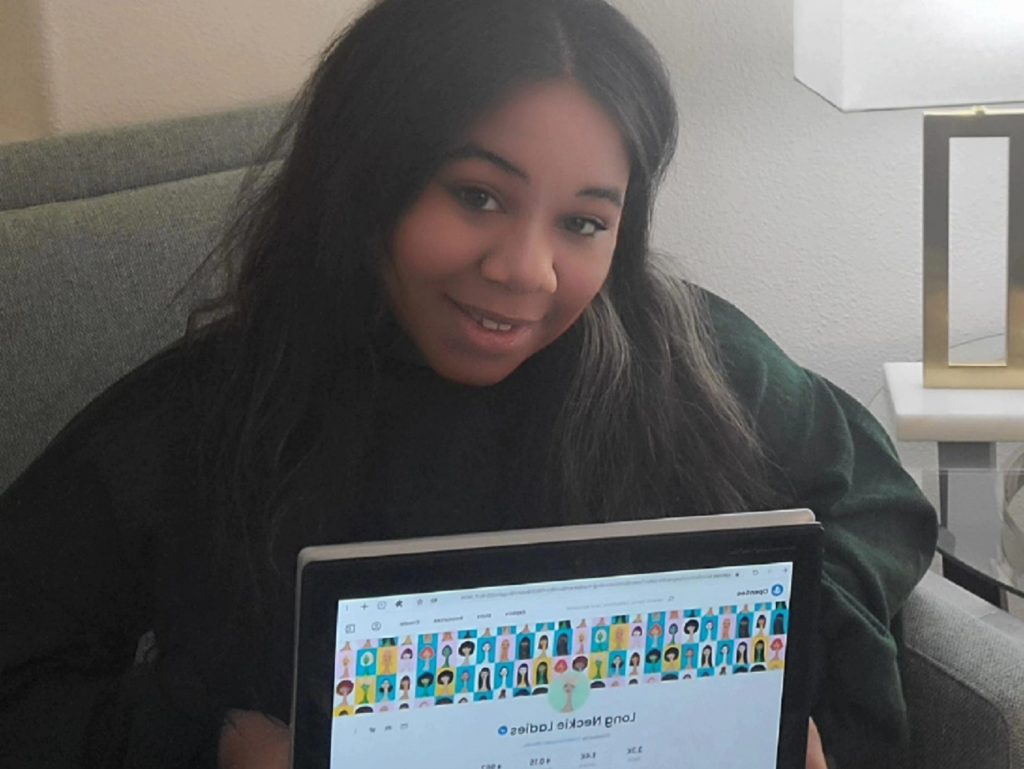- Nyla Hayes started drawing when she was 4 years old and created the Long Neckies when she was 9.
- She’s created both JPEG and generative art NFTs from her phone and tablet.
- She uses apps downloaded from Apple’s store to create her artwork then transfers them to OpenSea.
Nyla Hayes began drawing when she was about 4 years old — and she loved it.
When she turned 9, she started to draw what she calls Long Neckies, sketched portraits of women from diverse backgrounds who have long, narrow necks.
“My favorite dinosaur was the Brontosaurus and I was really into dinosaurs at the time,” said Hayes, who is now 12. “So I wanted to add that to my Long Neckies because I thought it was super cool.”
To Hayes, the dinosaur’s long, thick neck represents something that is powerful and strong, and she thinks of women in that way.
“And that’s basically what I want to show for my artwork, how beautiful and strong and powerful women can be. And it doesn’t matter your culture or your background, all of the women are beautiful basically,” Hayes said.
Her artwork has become popular among non-fungible-token enthusiasts, who are snapping up blockchain-backed digital artworks at a record pace.
Hayes' first collection, known as Long Neckie, was released on March 10th. It included a collection of 75 pieces, 51 of which have sold. She drew some of that artwork when she was 9, and plans to continue adding to this collection every year.
She released her second and larger collection, Long Neckie Ladies, on July 27. It included 3,333 women's portraits, and "it sold out in hours," said Hayes' mom Latoya. Nyla has since created a male counterpart known as the Long Neckie Fellas.
She was also the first artist to have a collection for TIMEPieces, a web3 platform from Time Magazine for NFTs.
To date, her artwork has earned 1,394 ETH in primary and secondary sales, or about $5.8 million based on ether's trading price on Monday, according to transaction records on the OpenSea and KnownOrigin marketplaces. Hayes has earned 382 ETH ($1.61 million) in primary sales before expenses like developer pay and gas fees.
2021 has been a good year for creators like Hayes. As interest in cryptocurrencies soared, NFT trading volumes rose above a record $6 billion in Q3, according to NonFungible.com.
But some experts like the crypto billionaire Mike Novogratz have warned that the boom will not last forever. And others who compare NFTs to physical art say the digital collectibles thrive on an artificial sense of scarcity.
As for where Hayes' creative ideas come from, she says she draws inspiration from both the real and digital worlds.
"I try to get inspiration from almost, like, anything, but usually I can get it from certain colors, or I get most of my inspiration off of Google or Pinterest," Hayes said. "But I do want to travel the world so I can actually see it in person. And I can have some inspiration from that too."
How she got started
Hayes' family knew that she wanted to pursue art. But the traditional art world had barriers to entry. Figuring out how to get art displayed at a gallery or even just posting it on a website and shipping it out can be challenging.
"At the time we didn't really have enough money to do something with my art," Hayes said.
Hayes' uncle knew about her passion and suggested she look into NFTs. Her dad and brother then hopped onto the idea and helped her with the technical process.
At first, Hayes was just drawing images using an app on her phone. But when she began to understand more about NFTs, she wanted to find ways of improving her work. She started using an iPad which gave her a bigger canvas. Hayes then downloaded a painting app called Procreate.
For her first collection, Long Neckie, once the art was done, she saved the images as JPEGs, transferred them over to a computer, then uploaded them for minting on OpenSea. She has also used KnownOrigin, another NFT platform that is on the Ethereum blockchain for one of her smaller collections.
Her larger collections such as the Long Neckie Ladies and Fellas were generative art. For this project, she partnered with developers such as The Andi Rutz Group and the Cosmic Paws team.
This process required Hayes to layer each property of the image by drawing features such as the eyes, nose, and hair separately. Each item was saved and sent to the developers who then created randomized computer-generated pieces.

